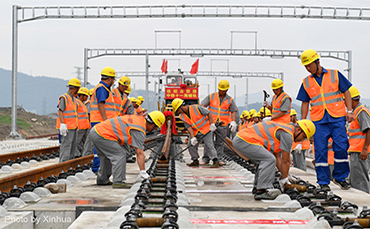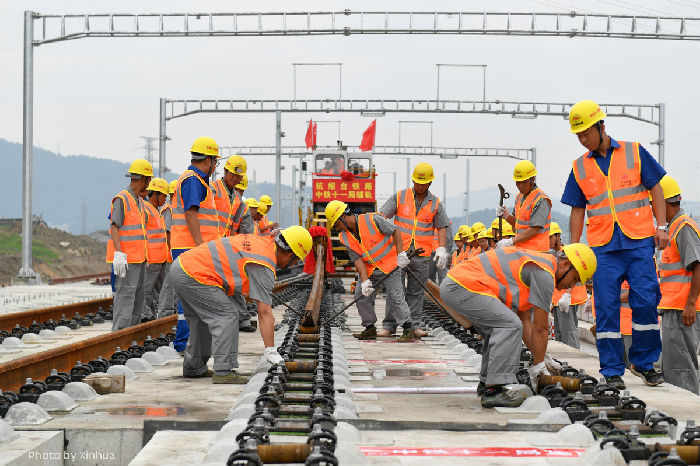



▲ Workers lay the track of the Hangzhou-Shaoxing-Taizhou high-speed railway in Wenling, East China's Zhejiang province. [Photo/Xinhua]
5. Enhancing the level of integration
To promote the integration of comprehensive transportation with the convergence of multiple rail transport, accelerate the intelligent upgrading of rail transport relying on information technology innovation, build a high-level interconnection infrastructure system, lead the regional economic and social development with rail transport supporting.
Strengthening seamless transport connectivity. To deep develop the connection and coordination in planning and construction, operation and management, policies support, and other relative aspects of the rail transit system, promote facilities jointly construction and resources sharing. To coordinate the rail line direction, station coverage, construction timing, and functional division of the same transport channel, and jointly access the convergence of the rail line system, transport capacity allocation, transport management, and service quality, enhance the distribution and radiating functions of a comprehensive transport hub, strengthen the systematization and coordination of comprehensive transport with the infrastructure interconnection of rail transport integration.
Promoting integrated service. To break the geographical range limits, administrative boundaries, and industry management division, promote information interconnection, ticket mutual recognition, security mutual trust, payment mutual support, management intercommunication based on the interconnection of various rail transport facilities. To accelerate the building of unification of signage, information platforms, service standards, and assessment systems, and achieve the goal of the integrated operation, management and service step by step. To create a transport service brand of Yangtze River Delta on rail, select operation and service demonstration lines of various rail transport systems. To encourage the development of multi-mode transportation and modern rail logistics.
Speeding up intelligent transformation. To strengthen the application of modern information technology in the field of rail transit, deepen the integration and development of 5G, internet of things, cloud computing, AI, blockchain, big data, Beidou navigation satellite with the rail transit system, nurture the digitalization and networking of infrastructure and vehicle, enhance the intelligent levels of operation scheduling and control. To implement intelligent upgrades of existing infrastructure and management control system, expand the terminal application of mobile phones, innovate the transport organization and service mode.
Promoting integrated development. To emphasize the supporting and leading effects of rail transit in regional urban space expansion, reasonable population distribution, and optimizing the layout of industries, intensify the comprehensive development of land along the rail transit lines and stations. To optimize the planning and utilization of ground and underground space of rail transit hubs, parking lots, and depots, unify the planning, coordinate the construction and management, build a rail transit station urban complex, extend the comprehensive service function of rail transit, promote the integrated development of the station, urban, industry, people, and culture to increase the overall efficiency and performance. The local governments and rail enterprises are encouraged to build a series of “rail transit streets”, “rail transit micro-centers”, and “rail transit communities” relying on railways and railway stations, consequently, to relieve the inessential function of super-large and large cities, and build the Yangtze River Delta on the rail of substance. To establish a framework of “rail + estate”, support rail transit construction and operation with comprehensive development benefits, and facilitated positive interaction between the rail transit and urban development to achieve a win-win outcome.
6. Guarantee Measures.
(1)Strengthen coordination and promotion.
Under the leadership of the Leading Group for Promoting the Integrated Development of the Yangtze River Delta, to innovate and improve the system and mechanism, expedite the construction of trans-regional and trans-departmental coordinating and promoting mechanism for the multi-level rail transit development in the Yangtze River Delta, negotiate and solve the issues such as planning, construction scheduling, funding raising, operation organization, subsidy sharing, etc. To deepen the innovation in cooperation mode between local governments and rail enterprises, establish a rail transit company of the Yangtze River Delta, which is responsible for regional rail transit planning and construction, operation and management, and explore self-built and self-operated mode.
(2)Broaden the finance options.
To take forward the market-oriented reform, the local governments and rail enterprises jointly establish a holistic framework for investment, construction, operation and management, speed up fair access for comprehensive development of stations along the railways, promote a serial of rail transit projects with predictable benefits as investment and financing reform pilots, encourage the participation of social capital, especially the private capital. Subject to the to defuse local government debt risks, increase the local financial input, launch the railway projects which are supported by a certain percentage of the amount of local government special-purpose bonds.
(3)Improve supporting policies.
To establish a sound and comprehensive policy guarantee for the integrated development of multi-level rail transit, improve the land comprehensive development support policy, update the technical standards for the connection and system control of various rail transit modes. Charging standards, clearing rules, and other market-based services including the use of various rail transits, station services entrusted transportation will be streamlined. Management systems for construction supervision, mutual recognition of security inspection, combined ticket for multimodal transport, operation and dispatch will be carried out. Rail transit service standards and assessment indicators will be formulated.
(4)Promote project construction steadily and orderly.
The provinces and cities in the Yangtze River Delta should shoulder due responsibilities on implementing the plan, coordination, resolving and allocating planning objectives and tasks, and advance the major projects annually according to the schedule and review the work progress regularly. For inter-provincial (intercity) railway as well as urban and suburban railways, relevant provinces and cities can approve by sections after reaching a consensus on the construction plan, explore the feasibility of a joint approval system. The rail enterprises should actively support local government to implement the development plan of multi-level rail transit, and strengthen the consultation with other enterprises as equals, cooperate to promote the implementation of new projects, reformation and utilization of existing inter-provincial (intercity) railways as well as urban and suburban railway. Relevant departments of the State Council will actively support the construction of multi-level rail transit in terms of land use, environmental impact assessment, safety supervision, etc., summarize and promote good experience and practices, and evaluate and adjust the plan timely.
7. Environmental Impact Assessment and Requirements
(1)Comprehensive Assessment
The plan will facilitate the national strategy of the Communist Party of China Central Committee and the State Council to implement the integrated development of the Yangtze River Delta, and will be delivered in tandem with the Outline of the Integrated Regional Development of the Yangtze River Delta and the Plan of the Higher -quality Integrated Regional Development of the Yangtze River Delta. Following the vision of sustainable development, focusing on improving the integrated utilization of resources, and coordinating the planning layout with the regional ecological environment management requirements including ecological red line, environment quality bottom line, resource utilization limit, and environmental access list. As a green and low-carbon transport mode, the construction of rail transit fully corresponds to the national strategy of energy structure adjustment and energy saving, and the negative environmental impacts are controllable. The implementation of the plan plays a vital role in promoting regional ecological civilization.
(2)Ecological Environment Protection Measures
First, to emphasize ecological conservation. To strictly enforce the eco-environmental red lines and follow the basic principles of “prioritizing conservation, avoidance first”, no construction projects may be conducted within the core zone of nature reserves where are explicitly prohibited by laws and regulations, prioritize avoiding other environmentally sensitive areas outside the construction prohibited area. Where it is impossible to avoid under special circumstances, the projects shall pass harmlessly. Meanwhile, strict eco-environmental conservation measures shall be implemented to reduce the negative impacts on these areas. The system that “environmental protection facilities and major projects are planned, constructed and used at the same time” shall be implemented, and environmental supervision, conservation of water and soil, and ecological environment restoration shall be strengthened.
Second, to intensively use the land. To protect farm land, prioritize using stock land, combine the planning process of land reclamation and project construction, adhere to the comprehensive utilization of land resource and transport channels, efficiently implement the comprehensive land development.
Third, to promote energy-saving and the reduction in carbon dioxide emissions. To take comprehensive energy-saving and efficiency management measures, develop advanced applicable technologies in energy-saving and the reduction in carbon dioxide emissions. To accelerate the research and application of new intelligent, energy-saving and environmentally friendly technical equipment, enhance the overall standards of energy efficiency and energy-saving in rail transit.
Fourth, to control pollution. To adopt comprehensive measures to solve the issues of vibration and noise along the rail transit lines, strictly control and carefully deal with various contaminants.
Fifth, to abide by laws and regulations on environmental protection. To implement the system of environment impact assessment, go through the formalities of project approval and permission of land, environmental protection, and energy-saving.
Source: UPSC & National Development and Reform Commission
Edited and translated by Guo Xinxin